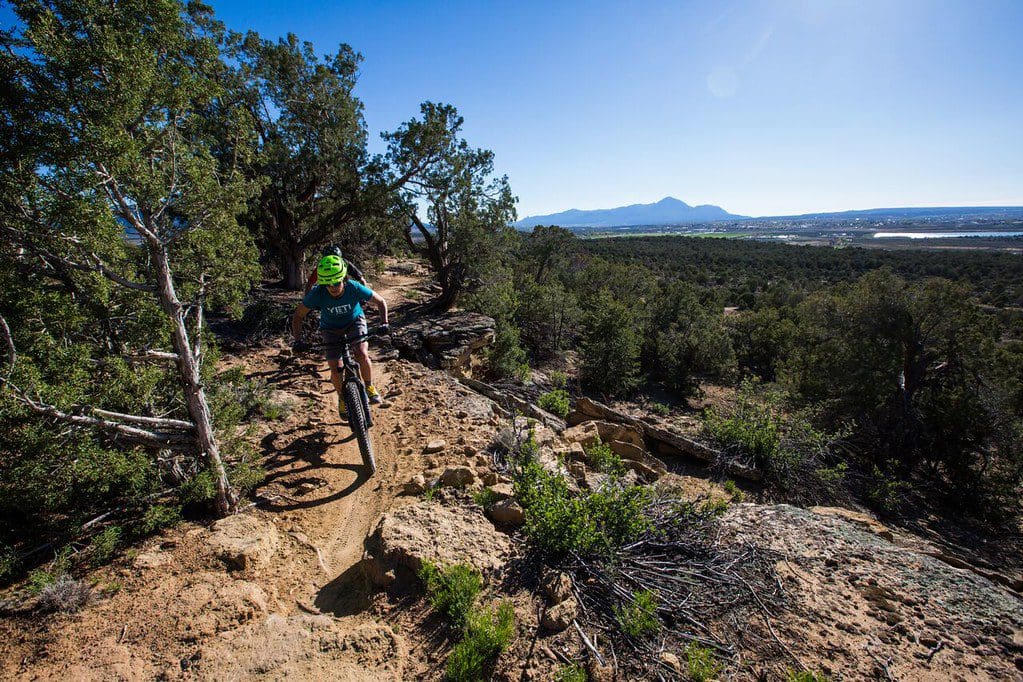|
Getting your Trinity Audio player ready...
|
Established in 1906
Mesa Verde, an archeological marvel and UNESCO World Heritage Site, draws the attention of visitors from all over. Its towering sandstone cliffs contain intricate and mysterious dwellings of the ancient Puebloan people, waiting to be explored.
Overview
Mesa Verde National Park is located in Southwest Colorado is known best for its well-preserved Ancestral Puebloan cliff dwellings. The park is located in Mesa Verde, Colorado about 36 miles west of Durango. Mesa Verde offers an unparalleled opportunity to see and experience unique cultural history while taking in breathtaking views and hiking beautiful trails.
Mesa Verde will take you back in time to when the Ancestral Puebloans lived among the cliffs and rocky mesas for 700 years. The Mesa Verde plateau was home to the ancient Pueblo peoples from the 6th to 12th centuries. Researchers have discovered over 4,000 archaeological sites, with many of them being cliff dwellings.
Among the sandstone alcoves are preserved 600 cliff dwellings, sheltered from view by overhanging bluffs. Deep into the rock have been dug ceremonial sites known as kivas. These sites are among the best kept archaeological relics anywhere. As you imagine the lively population that once inhabited these ruins, it’s almost like they’ve come alive again.
The grandest of all sites is the Cliff Palace, boasting an impressive 150 rooms. It’s breathtaking to admire from a distance, but even more exciting to ascend the wooden ladders and explore its myriad chambers during a guided tour by a knowledgeable ranger. Visitors can also take led tours of Balcony House and Long House. There are also roads and paths leading to other mesa villages-allowing visitors to explore the area up close.
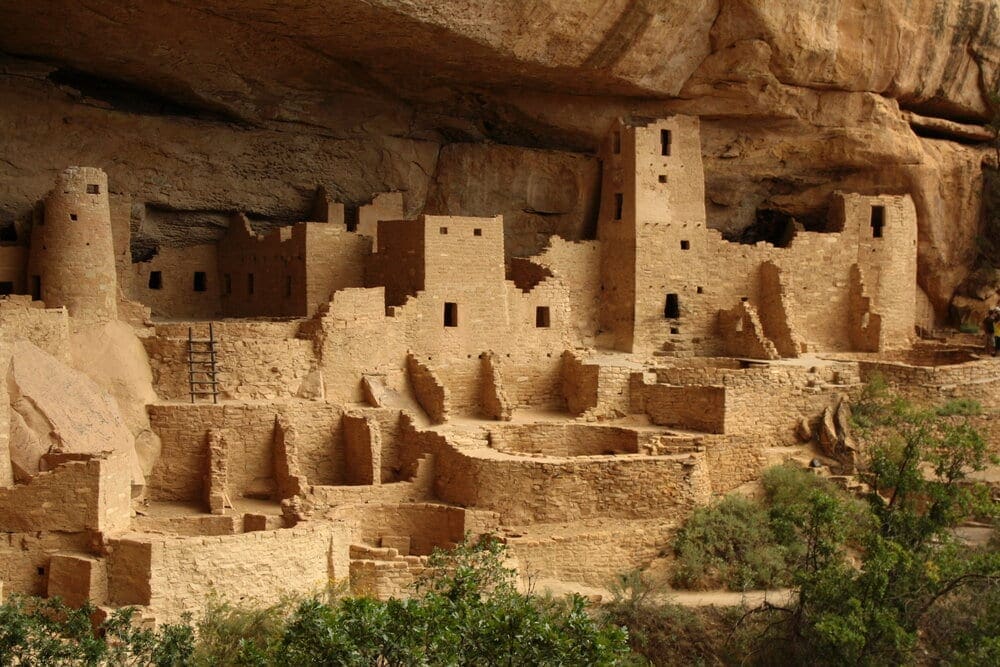
Cliff Palace is the largest cliff dwelling.
Table of Contents:
Article Navigation: Click on any of the listed items in the table of contents below to jump to that section of the article. Similarly, clicking on any large, white section header will jump you back to the Table of Contents.
Human History
By the year 550, the Ancestral Puebloans’ had shifted from a nomadic life to building pithouses on the Mesa. In the following two centuries, their settlements grew larger as they started farming and manufacturing pottery. The transition from pithouse residences to multiple-story stone homes marked the beginning of the Pueblo age. There are no written documents left behind, but three million artifacts—including weapons, pots, tools, and baskets—have been discovered at Mesa Verde. These provide an interesting glimpse into the lives of the Ancestral Puebloans.
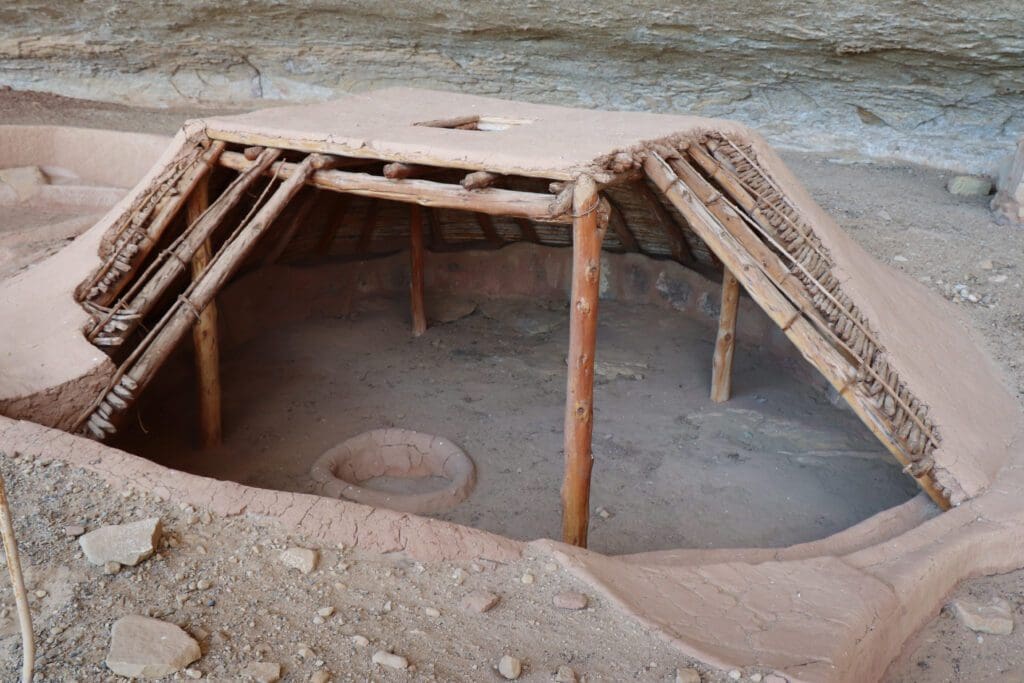
Reconstructed ancient pithouse dwelling in Mesa Verde National Park, Colorado. Photo by SKPG_Arts/Adobe Stock.
Between AD 1190 and 1280, the Ancestral Puebloans established many large unified pueblos with over 600 cliff dwellings. It is uncertain why they relocated from their perch atop the mesas to the hidden rockface structures; it may have been for protection or defense. The tall walls of sandstone blocks were neatly fitted together, demonstrating how advanced these builders were. The dwellings varied in size, ranging from accommodations for a single family to intricate complexes with numerous chambers used for living and storing food provisions. Many of the rooms had plastered interiors adorned with beautiful murals.
The Puebloan people left modern-day Colorado in the late 1280s. The reasons behind the Ancestral Puebloans’ relocation remain a mystery. Some experts believe it was due to climate change during the 13th Century that caused severe drought in the region, leading to crop failure. It is believed that they headed south to join existing Pueblo communities in New Mexico and Arizona, where their descendants live today. The cliff dwellings that were left behind by the Puebloans are some of the most notable and best-preserved in all of North America.
The sprawling ruins were so remote from any civilization that they weren’t discovered until the 16th Century when the Navajo happened upon the abandoned villages. Later in the 19th Century, Anglo-Americans started to hear about the wonders of the mesa and began entering on their own. Widespread destruction and looting followed.
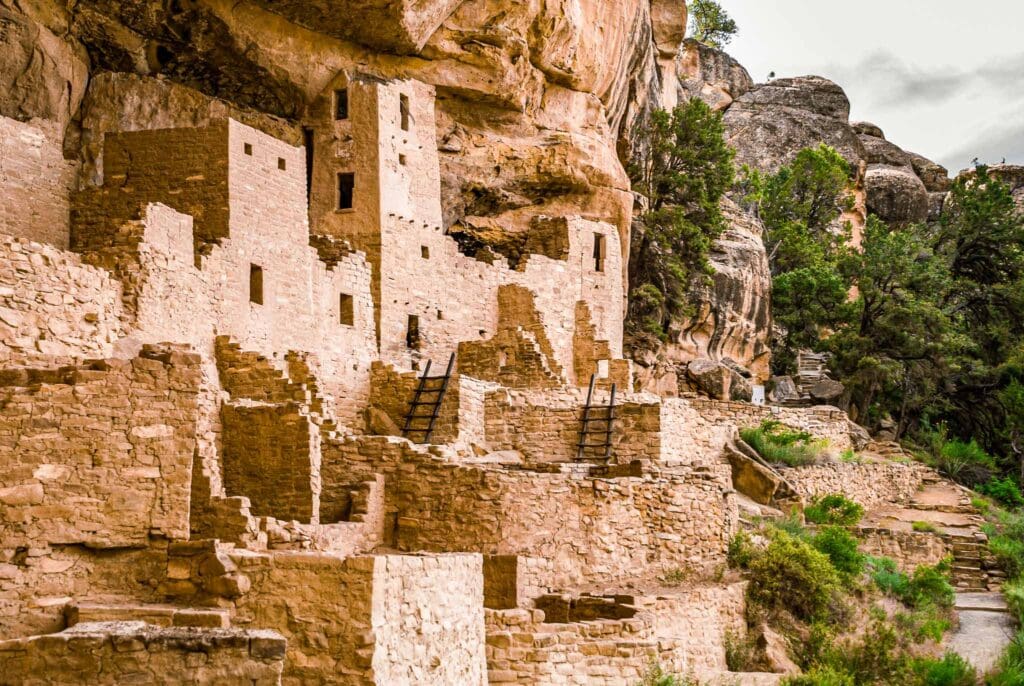
Cliff Palace at Mesa Verde National Park. Photo by Kathryn/Adobe Stock.
Rock Art and Murals
Rock art is found throughout the Mesa Verde region, but varies in location and style. It is abundant in the middle San Juan River area, likely due to its importance as a travel route and water source. Common motifs include anthropomorphic figures, handprints, tracks, wavy lines, spirals, concentric circles, animals, and hunting scenes. As the region’s population declined, rock art began to depict shields, warriors, and battle scenes. The Hopi interpret Petroglyph Point’s petroglyphs as representations of various clans.
During the late Pueblo II to Pueblo III period (1020–1300), the Ancestral Puebloans created plaster murals in their kivas. They included painted and inscribed images of animals, people, and designs from Basketmaker III (c. 500). Motifs such as geometric patterns resembling pottery symbols and zigzags representing basket stitches were common. Colors included red, green, yellow, white, brown, and blue. The designs were also used by the Hopi later on.
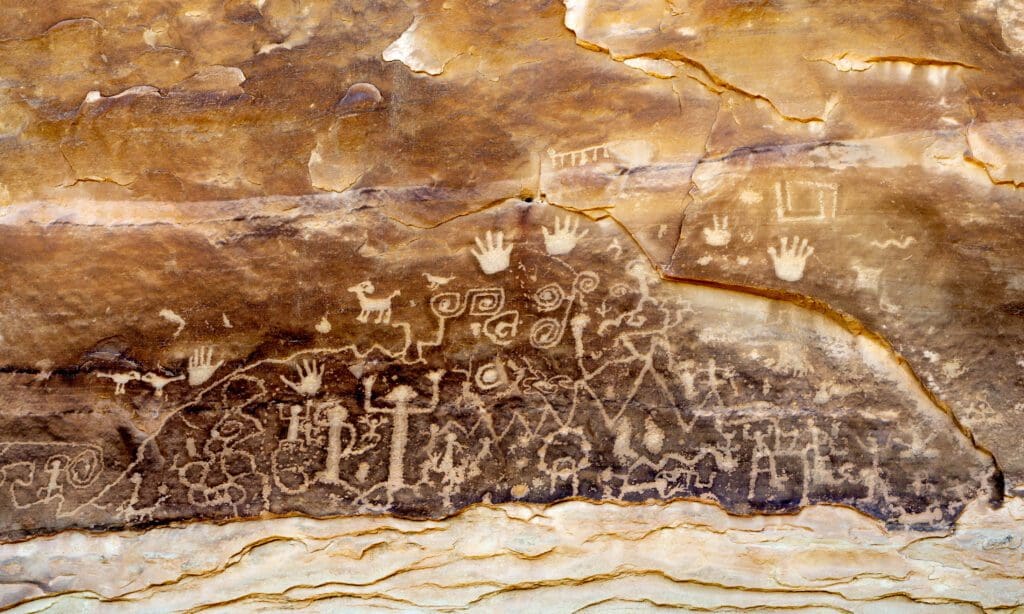
Petroglyph Point, Mesa Verde National Park. The panel at the end of the Petroglyph Point Trail.
Rediscovery
In 1776, Mexican-Spanish missionaries and explorers Francisco Atanasio Domínguez and Silvestre Vélez de Escalante sought a route from Santa Fe to California. They reached the tree-covered plateaus of Mesa Verde region, but never saw the ancient stone villages due to their angle. They were the first Europeans to travel through much of the Colorado Plateau into Utah and back through Arizona to New Mexico.
The Utes were recognized owners of Colorado west of the Continental Divide in 1868. A new treaty in 1873 left them a strip of land from the border with New Mexico to 15 miles north, containing Mesa Verde. The Utes did not inhabit the ancient dwellings, but found sanctuary and wintered in the warm canyons and high plateaus of Mesa Verde, believing it sacred ancestral territory.
In 1873, John Moss reported his observations of Mesa Verde to prospector William Henry Jackson. The following year, Jackson photographed and publicized the typical stone cliff dwellings in Mancos Canyon. His reports were included in the 1876 report of the Hayden Survey, resulting in proposals to systematically study Southwestern archaeological sites.
The Wetherills, a family of cattle ranchers near Mancos, Colorado, were allowed to bring their cattle onto the Ute reservation during the winter with the tribe’s approval. Acowitz, a member of the Ute tribe, told them about a special cliff dwelling in Mesa Verde and how it was a sacred place that the Utes never ventured to.
On December 18, 1888, Richard Wetherill and Charlie Mason found Cliff Palace. Wetherill named it. The group explored the ruins and gathered artifacts, some of which they sold to the Historical Society of Colorado. Frederick Chapin also visited during 1889 and 1890. He documented the landscape and ruins in an article and book.
In 1891, the Wetherills opened their home to Gustaf Nordenskiöld, the son of polar explorer Adolf Erik Nordenskiöld. Gustav was a mineralogist and applied scientific methods to documenting artifacts from the Mesa Verde region – taking photographs and making diagrams along with referencing literature from archaeological records. He collected many artifacts and sent them to Sweden’s National Museum of Finland before he published his book “The Cliff Dwellers of the Mesa Verde” in 1893. This event sparked worries about protection for the area’s resources as well as the need to conserve its land.
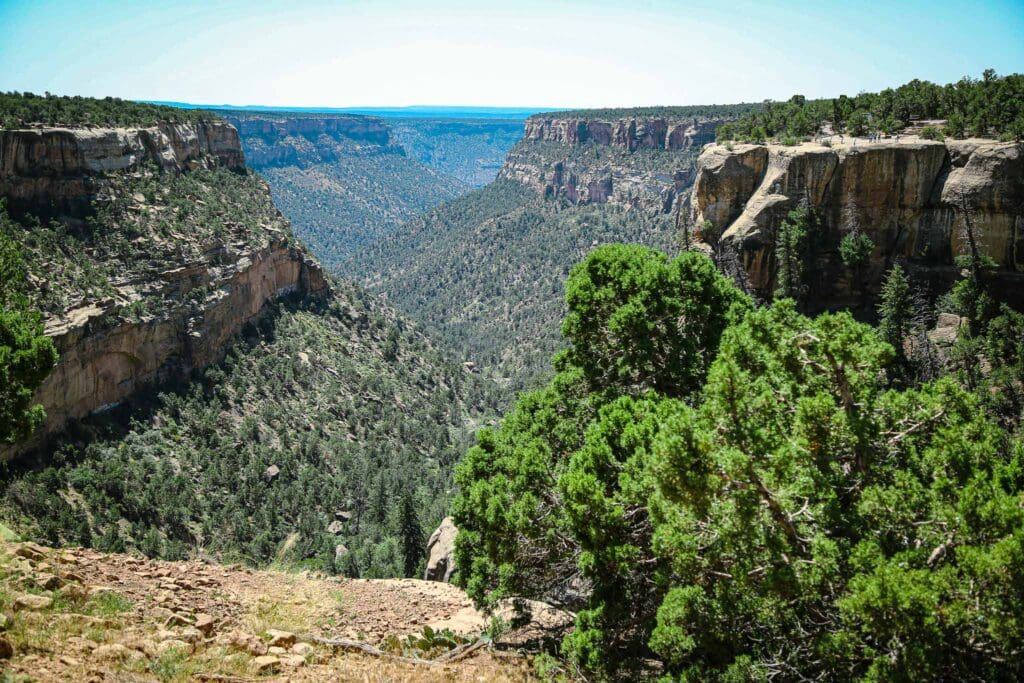
Navajo Canyon, Mesa Verde National Park, Colorado. Photo by Stefano/Adobe Stock.
To Preserve the Works of Men
In 1882, journalist Virginia Donaghe McClurg made her way to Mesa Verde and was among the first of white women to lay eyes on the cliff dwellings. She, alongside activist Lucy Peabody, known as “the mother of Mesa Verde,” founded the Colorado Cliff Dwellings Association in order to protect these ancient marvels through her writings, speeches, and fundraising efforts.
Together they raised awareness of Mesa Verde’s importance by engaging with the Federation of Women’s Clubs and the press– their work was so crucial that it directly led to the establishment of Mesa Verde National Park.
In 1889, Goodman Point Pueblo became the first pre-Columbian archaeological site in the Mesa Verde region to gain federal protection. It was the first such site to be protected in the US.
Towards the end of the 19th century, it became evident that Mesa Verde needed to be safeguarded from those who took and sold artifacts. Currently, many of these artifacts are in museums and private collections around the world; a notable example is a collection at the British Museum in London.
To protect this place of cultural importance, President Theodore Roosevelt signed the Mesa Verde National Park and the Federal Antiquities Act of 1906; it was named after its rich juniper and piñon forests, as “Mesa Verde” is Spanish for “green table”. This was the first ever park created for the preservation of man-made works.
In 1976, an area of 8500 acres was set aside as a protected wilderness. These three distinct sections were placed along the higher elevations surrounding Mesa Verde National Park, forming a buffer to preserve some of the most important Native American sites. Unlike other wilderness areas, visitors are not allowed into this part of the park; in fact, no one is permitted to enter its backcountry.
Mesa Verde National Park was recognized around the world as a UNESCO World Heritage Site in 1978. It is one of the most significant archeological sites on earth and serves as an educational platform for teaching people about preserving and safeguarding our global treasures.
Mesa Verde National Park has expanded to encompass a total of 52,000 acres, with 5,000 archaeological sites and 600 cliff dwellings, along with over three million artifacts in the park’s collection.
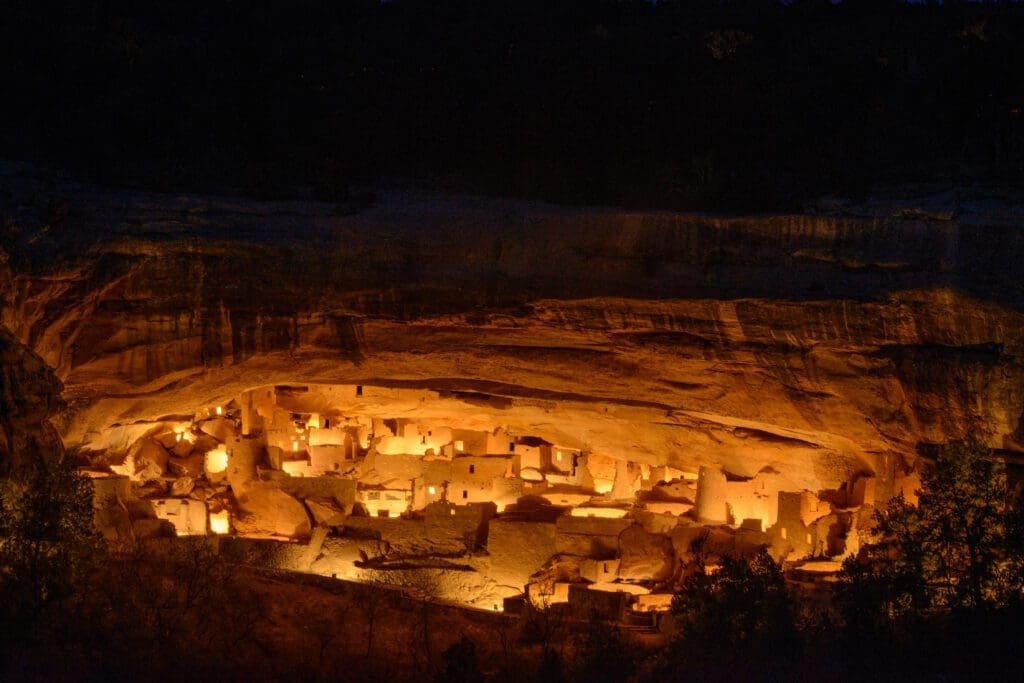
Cliff Palace ruin at Mesa Verde National Park illuminated by lanterns to celebrate the 100 year anniversary of the National Park System. Photo by cbdusty/Adobe Stock.
Geology
Mesa Verde is a misnomer, as the area does not fit the geological definition of mesa. The park consists of several cuestas between canyons, and its slant created alcoves that have preserved the cliff dwellings.
The unique geology of Mesa Verde National Park was made when the Western Interior Seaway washed over part of the North American Continent, advancing and retreating with changes in climate. Today, you can still see the remains of shale deposits from the Sea’s movements and resemblance showing how the rock was carved to create the Mesas in the park today.
In the late Cretaceous Period, the Mancos Shale was deposited on top of the Dakota Sandstone in Colorado. The shale’s clay content causes it to expand when wet, resulting in terrain sliding. Above this is the Point Lookout Sandstone, which formed in shallow marine water and is 400 feet thick. Its upper layers host fossiliferous invertebrates.
The Menefee Formation is made up of carbonaceous shales, siltstones, and sandstones, deposited in semi-marine environments. It also includes thin coal seams. At its top, the Cliff House Sandstone intrudes upon it.
The Cliff House Sandstone is the area’s youngest rock layer, about 400 feet thick and yellow in color. It contains fossil beds of sea shells, fish teeth, and other invertebrate remains. The shale zones indicate where alcoves were formed for Ancestral Puebloan dwellings.
The Cretaceous and Tertiary periods saw uplift in the Colorado Plateau, San Juan Mountains, and La Plata Mountains that created the Mesa Verde pediment. Water eroded this, forming canyons. Today, with an arid climate, these erosional processes are slowed.
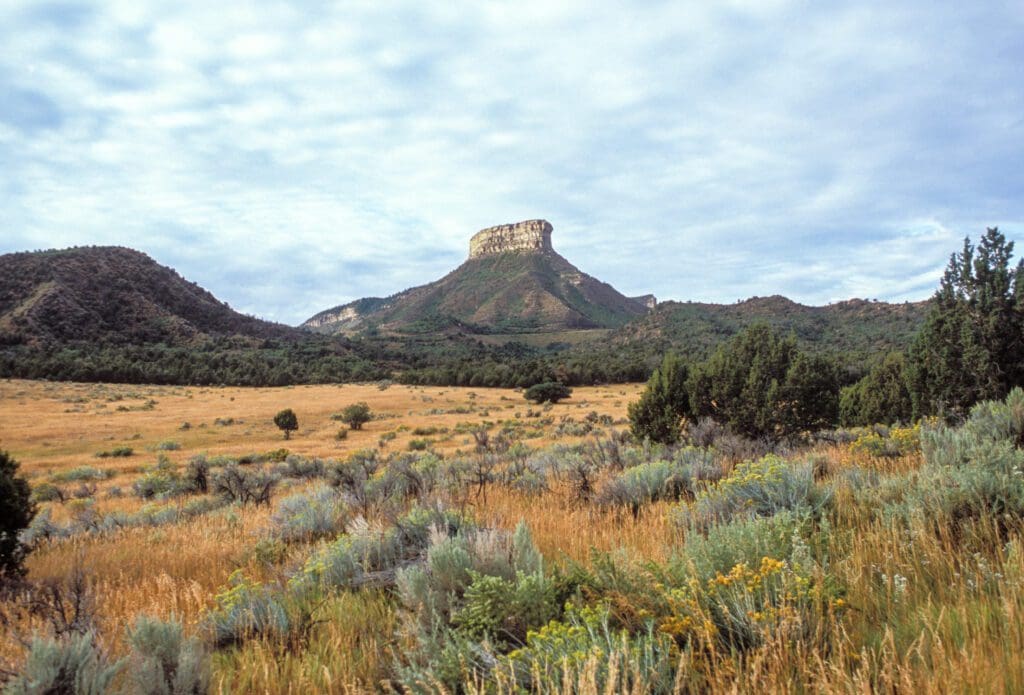
Point Lookout, Mesa Verde National Park. Photos by Andrew/Adobe Stock.
Where To Stay
Morefield Campground
There is one main campground to be enjoyed if you are thinking of camping at Mesa Verde National Park. Morefield Campground is located four miles inside of Mesa Verde and is one of the best campgrounds in Colorado. This is a fairly large site with over 260 tent sites. There is plenty of space and each site comes equipped with a table, bench, and a grill.
Camping is available for tents, trailers, and RVs. If you are traveling by RV, there are 15 full hookup sites. The Campground is situated in the middle of loop roads that traverse through high grassy canyons, full of native wildflowers, deer, and wild turkeys. Here, you will see spectacular views of surrounding valleys and mountains and even get a glimpse of some native animals.
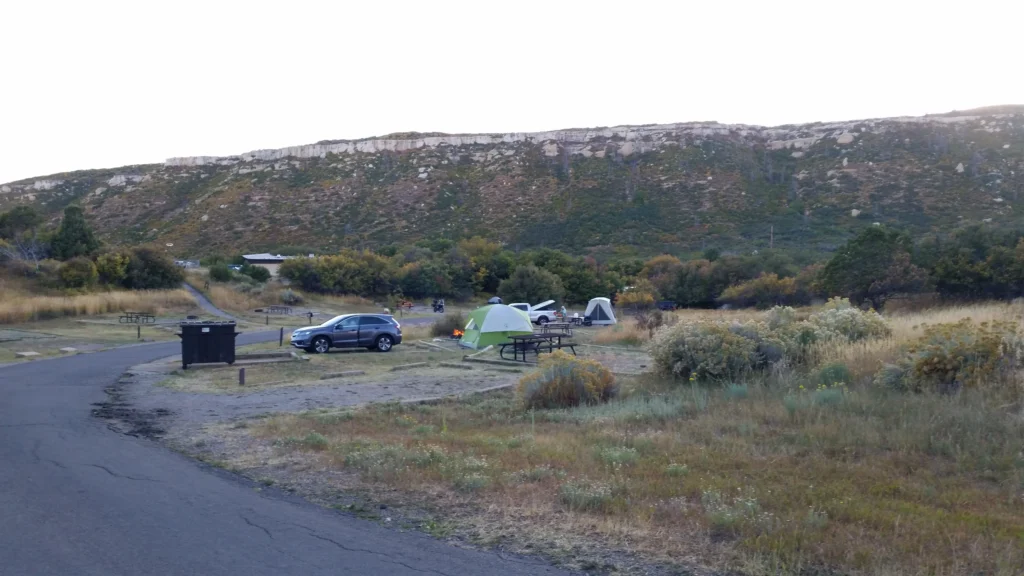
Morefield Campground. Photo by The Dyrt camper Dexter I.
The Morefield Campground is usually fully open from May to mid-October and limited camping is open from mid to end of April. Aside from the spectacular campsites and views, there is a full-service village that serves breakfast, has a gas station, an RV dumping station, laundry machines, showers, a gift shop, and even a grocery store.
Book your stay at the Morefield Campground
Far View Lodge
Far View Lodge is the only lodging inside Mesa Verde National Park, located 15 miles from the park entrance. Western décor welcomes guests for an unforgettable vacation with no distraction of TVs or cell phone service, but great wildlife watching. The lodge comprises 150 rooms in two room types: Kiva and Kiva Deluxe View.
Head to the Metate Room, where a variety of cultural dishes awaits. Native American artwork adorns the walls as you savor the modern cuisine, crafted with traditional ingredients and flavors from the area. Bring your hunger for a truly unique experience.
Book your stay at Expedia!
Jersey Jim Lookout Tower
Stay overnight in the historic Jersey Jim Fire Lookout Tower in Southwestern Colorado. Located in a San Juan National Forest meadow at nearly 10,000 feet, the tower housed U.S. Forestry Service fire lookouts from 1940-70s. It was renovated and saved in 1991 by a non-profit volunteer organization and now operates under a permit with the San Juan National Forest.
Book your stay!
Enjoying the Park
There are a number of options to enjoy Mesa Verde National Park. There is a lot of terrain in the park that is rugged and situated at high elevation, making for some great hiking. Aside from that, there are a variety of more accessible options including some of the archeological sites scenic overlooks, campsites, and even museums.
A trip to Mesa Verde National Park is not complete unless you pay a visit to the cliff dwellings. To get to the most remote and interesting cliff dwelling remains, it is recommended that you take a guided tour with a Park Ranger.
The Ranger will be able to tell you specific historical details about the cliff dwellings you are visiting and how long they have been there. If you don’t have time for a guided tour or want to do your own thing, you can drive up the Mesa Top Loop Road, which will take you to 12 different archaeological sites including surface sites and Cliff Palace. You can look down on the cliff dwellings while taking in the breath-taking view of Colorado.
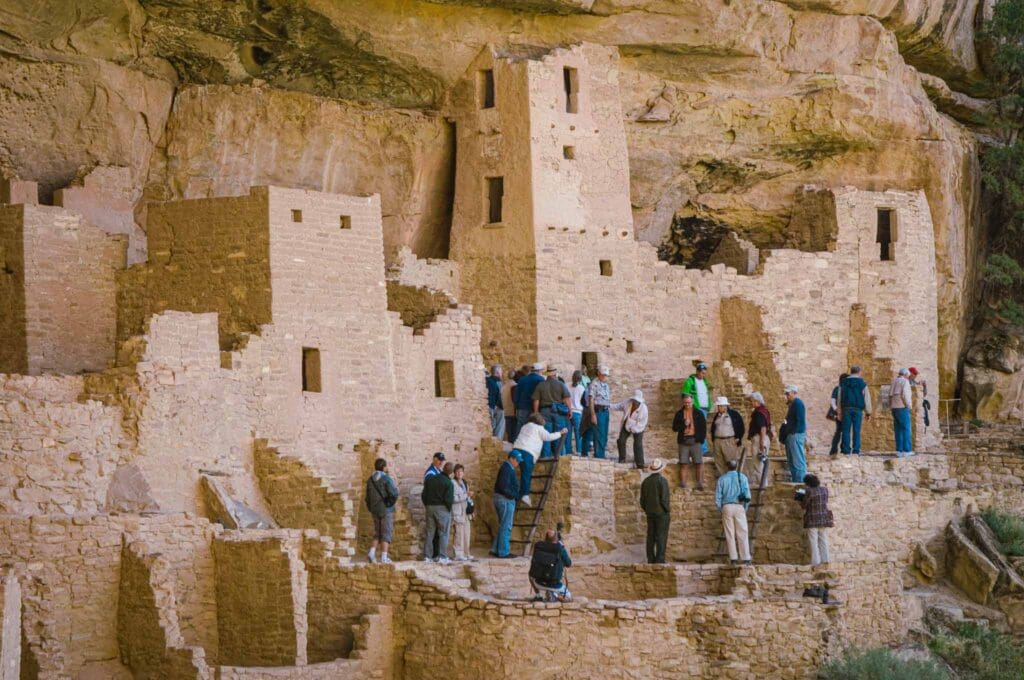
Hikers exploring the cliff dwellings at Mesa Verde National Park, Colorado. Photo by Rolf Nussbaumer/Danita Delimont/Adobe Stock
Good To Know: A kiva is a circular, underground room used by Puebloans for ceremonial and political meetings. Mesa Verde National Park’s kivas often have keyhole-shapes. Normally, there would be one kiva for every five or six rooms in larger communities.
Explore Cliff Palace
The Cliff Palace is an ancient, multi-story structure located in the biggest alcove of the Mesa Verde. It’s estimated to date back over 700 years and was built out of sandstone, wooden beams, and mortar. The walls were even brightly painted. This dwelling housed around 125 individuals and was more than likely a part of an even larger network of 60 pueblos. With 23 kivas and 150 rooms, it remains the largest cliff dwelling within the Mesa Verde National Park.
It takes an hour to take the tour (for a fee), but it’s well worth it. Hundreds of rooms and dozens of kivas lie within waiting to be explored. Ranger guides give insight into the day-to-day life of Ancestral Puebloans, allowing visitors to experience what their lives were like more than 700 years ago. Tour tickets can be purchased only on recreation.gov
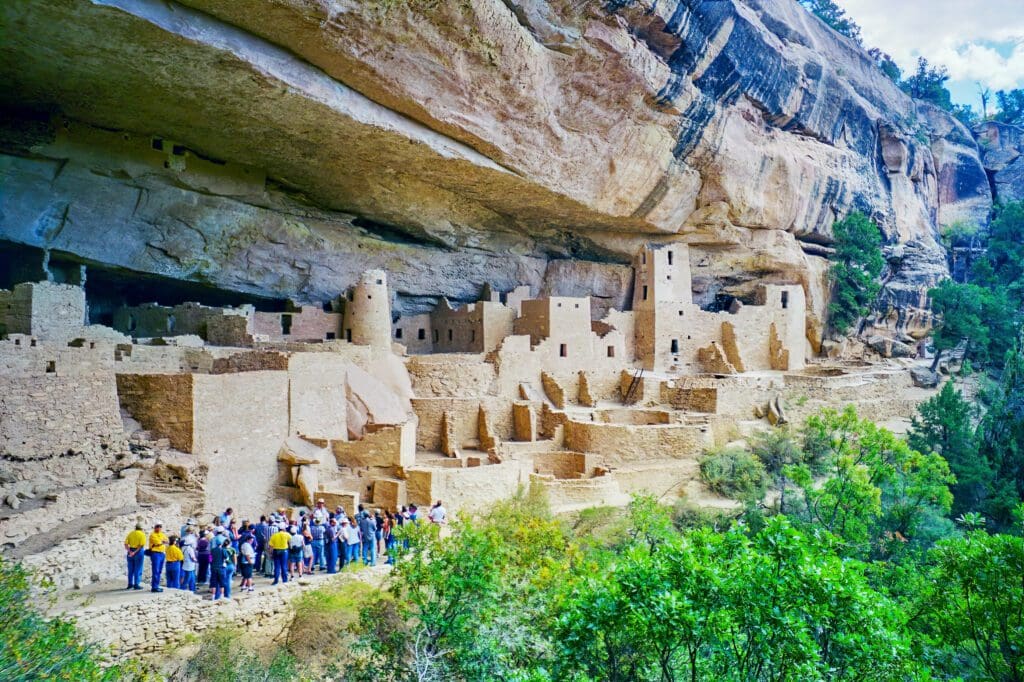
Cliff Palace in Mesa Verde National Park, Colorado.
Explore Balcony House
Balcony House was medium-sized with 38 rooms and two kivas, likely housing up to 30 people. There were two seep springs close by, one located in the alcove and another just beneath. Its alcove faces northeast, which meant its inhabitants experienced little sun exposure in the wintertime. It seems that access to water was given greater priority than warmth from the sun. Its only entry was via a 32-foot ladder and a 12-foot tunnel, which made it easy to defend. It was likely built before the Mesa Verde people migrated out of the area in 1278 and was excavated in 1910 by Jesse L. Nusbaum.
Ranger-guided tours (one hour, fee required) are the only way to enter Balcony House. Balcony House requires guests to go down a 100 foot stairwell into the canyon and ascend a 32 foot ladder. Afterwards, adventurers have to squeeze through a 12-foot-long tunnel which is 18 inches wide before climbing an extra 60 feet on ladders and stone steps. Venturing through Balcony House grants you sweeping sights of Soda Canyon. Guided tours are available from late spring to early autumn.
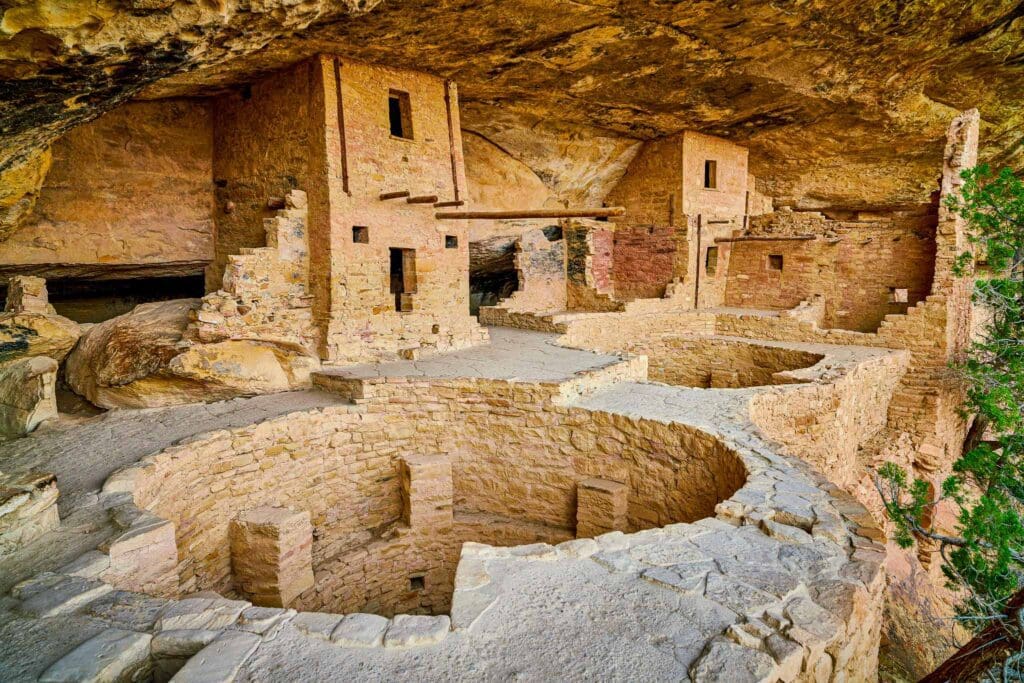
Balcony House at Mesa Verda Natioanl Park, Colorado.
Chapin Mesa Archeological Museum
The Chapin Mesa Archeological Museum holds artifacts that speak volumes about the ancient ways of life here; interestingly, this museum was made from Cliff House Sandstone, the same type of rock used to create these dwellings. The museum showcases a style of architecture known as Modified Pueblo Revival. This design was inspired by the architecture of Mesa Verde’s descendent communities.
Enjoy Some of the Country’s Darkest Skies
The Ancestral Pueblo people were skilled farmers and astronomers. After the sun sets, Mesa Verde visitors can experience a night sky just as the Ancestral Pueblo people did a millennium ago. The star-filled skies are an important cultural resource as well as a draw for those seeking celestial views.
Mesa Verde has the darkest skies in the US, due to its high elevation, dry climate, and low population. In 2021, it was certified as a Dark Sky Park for its efforts to protect the night sky. Though Mesa Verde’s sites, trails, and backcountry are closed at night, there are still many places to admire the dark skies.
Morefield Campground and Far View Lodge (May to October) offer stargazing, ranger-led evening programs, and expansive night sky views. Numerous overlooks along the park road also remain open to public access throughout the night.
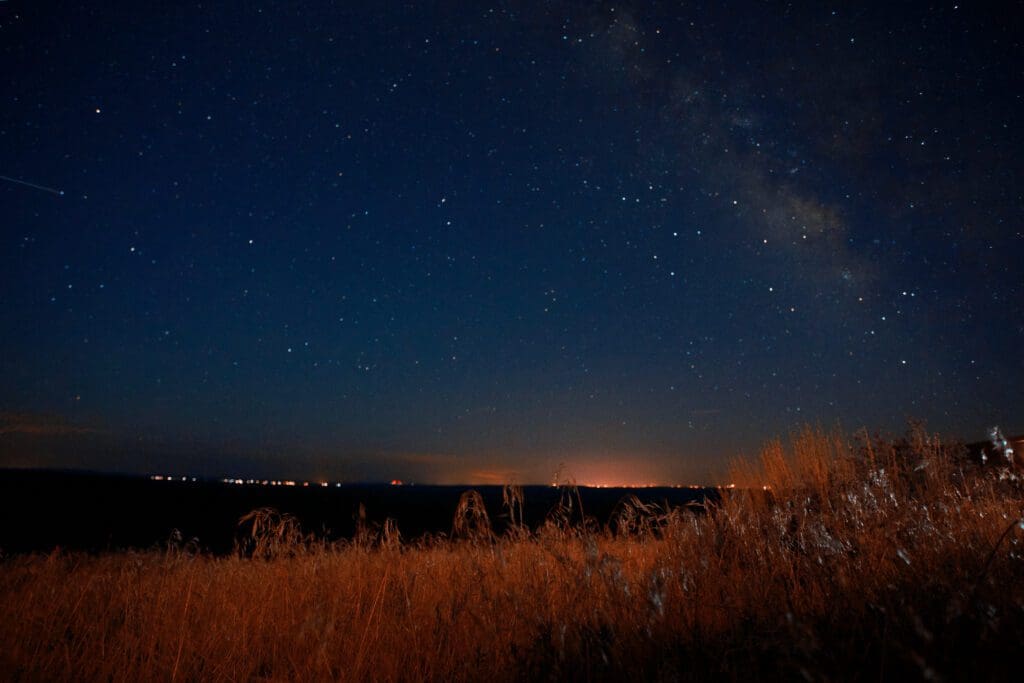
Starry sky over Mesa Verde National Park.
Best Hiking Trails
In Mesa Verde National Park, hiking is limited to designated trails. Luckily, there is no shortage of designated hiking trails to really enjoy.
Morefield Trailheads
There are numerous trailheads that start from the west end of the Morefield Campground. The Prater Ridge Trail is a longer hike, around 7.8 miles round-trip, It ascends the Prater Ridge, following a loop around the top of the ridge, returning along the same route.
The Knife Edge Trail is a shorter hike, only around 2 miles. It goes from the northwest corner of Morefield Campground towards the Montezuma Valley Overlook. Back in 1914, this trail was the main access to the park.
One last trail leaving from the Morefield Campground is the Point Lookout Trail. This is another short hike around only 2.2 miles that follows a switchback trail up the backside of Point Lookout and brings you to the top of the mesa. At this trail you will get excellent views of Montezuma and Macos valleys, along with the stunning, serene countryside.
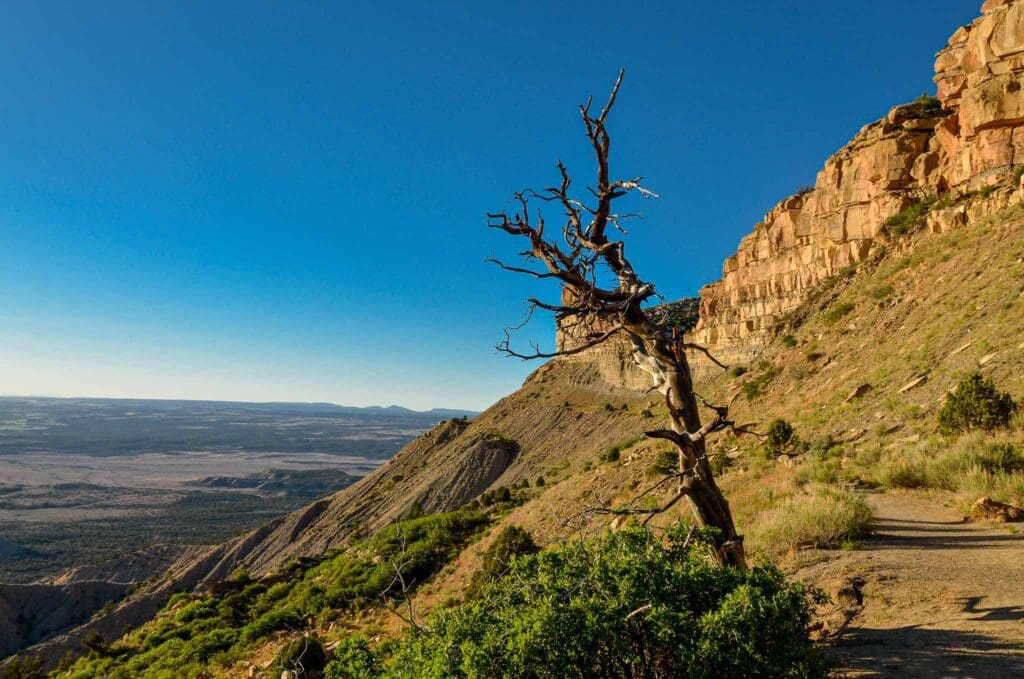
The Knife Edge rocks at sunset in Mesa Verde National Park. Photo by ssmalomuzh/Adobe Stock.
Chapin Mesa Trailheads
There are more trails that leave from the Chapin Mesa starting point. The most well known and well traveled trail from here is the Petroglyph Point Trail. Though it is only 2.4 miles but has some difficult sections. When reaching the end of the hike, you will have to get on hands and knees and scramble up the last final bit. Here you will see beautiful views of Spruce and Navajo Canyons, traveling past a large petroglyph panel about half way through the loop.
A shorter hike from the Chapin Mesa Trailhead is the Farming Terrace Trail. This one is only about half a mile, beginning and ending on the road to Cedar Tree Tower. This short trail leads to a series of prehistoric dams built by the Ancestral Pueblo people. These were made to create farming terraces. On this trial, you can expect to see wild animals such as lizards and hummingbirds. Depending on the time of year you are visiting the park, you should check in at the Ranger Station to make sure the trail is open and in safe conditions to be hiked.
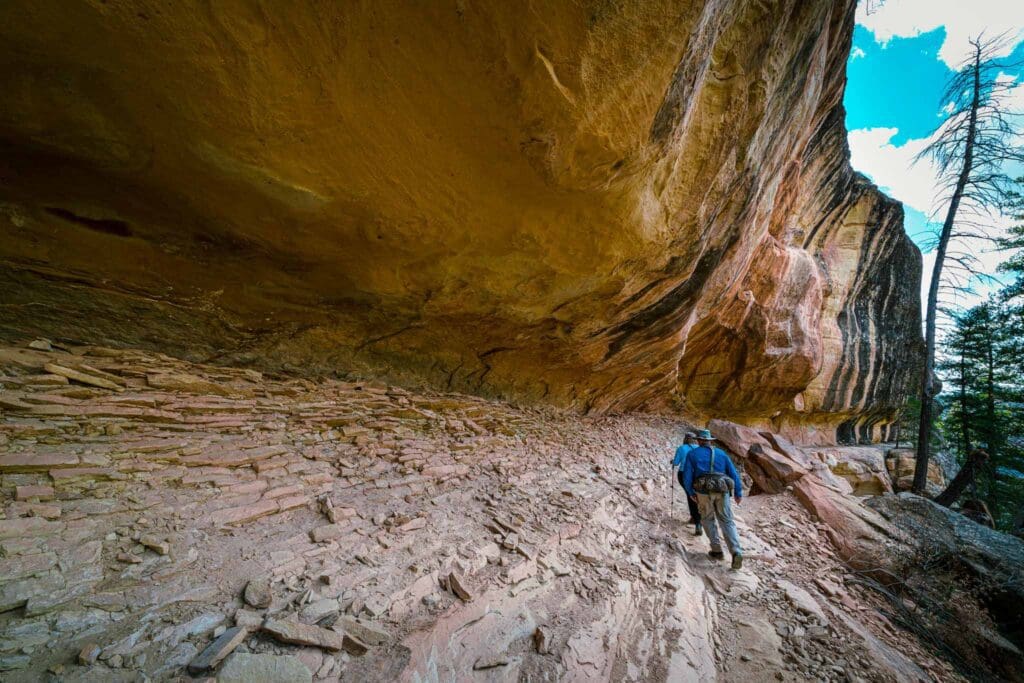
Trail to Mesa Verde’s Petroglyph Point, Mesa Verde National Park, Unesco World Heritage Site, Colorado. Photo by Juan Carlos Munoz/Adobe Stock
Cross-Country Skiing and Snowshoeing
In the winter months, Mesa Verde becomes a snowy wonderland, and the cliff dwellings become sparkly with ice. As Cliff Palace Loop Road is closed to vehicles, snowshoes or cross-country skis are the only way to explore the 6-mile loop. Without any tourists around, it’s the perfect time for adventurers to enjoy a peaceful journey through nature.
Mountain Biking at Nearby Phils World
Phil’s World is a mountain bike trail system located four miles out of Cortez, Colorado in the southwest desert, just outside of Mesa Verde. It offers a variety of single track trails with areas of challenging slickrock and ranges from beginner to intermediate difficulty. Most of the paths are not too difficult, but some steeper uphill sections can also be found. Those looking for an exciting ride will find plenty of features created specifically for mountain biking throughout the system.
The Phil’s World Trail System, one of the BLM’s “Backyard to Backcountry” gems, was planned out by IMBA with the Tres Rios BLM Field Office in Dolores, CO. Experts have provided detailed data on the trail, including its heights, ratings, conditions, pictures, and reviews.
Conclusion
Whether or not you are traveling to Mesa Verde National Park to experience the rich history that the park has to offer, or going to camp and explore the hikes, you will enjoy everything the park has to offer. With so much geological and historical significance, it is hard not to be awe struck by this National Park.
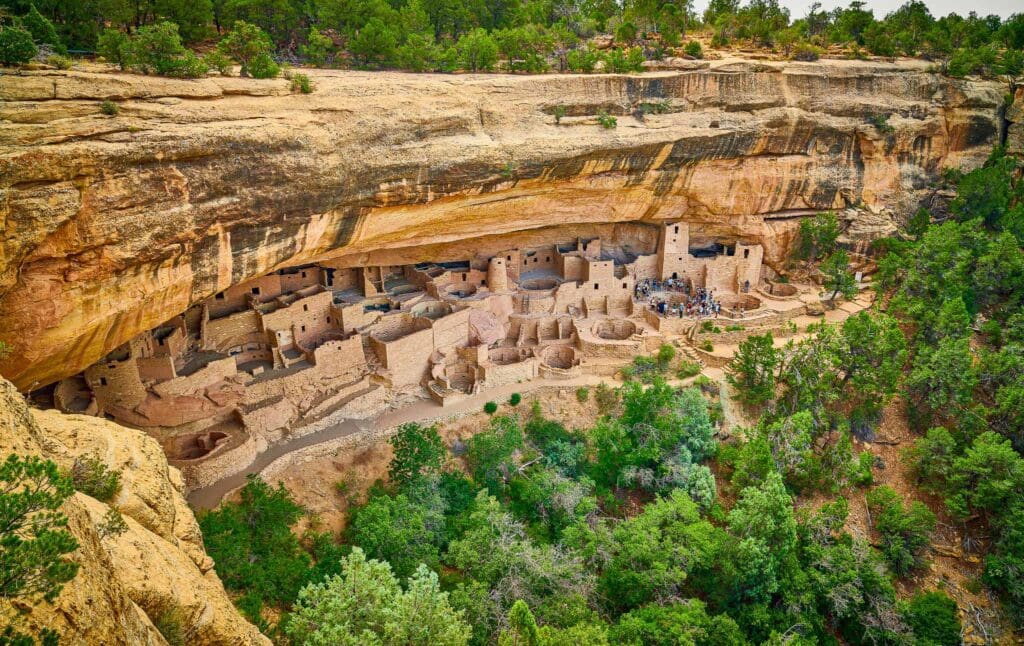
Tour of Cliff Palace at Mesa Verde National Park. Photo by Patrick Jennings/Adobe Stock
Skyblue Featured Video: Tour of Cliff Palace
Enroll With Global Rescue Prior To Embarking On Your Next Adventure.
When a travel emergency arises, traditional travel insurance may not come to your aid, and a medical evacuation can cost up to $300,000.
The cost when you have a Global Rescue membership? $0. That’s why when the unexpected happens, you want the leader in rescue, evacuation and medical advisory behind you. You want Global Rescue.
Popular Articles:
Guide to the Best Hiking Trails in Rocky Mountain National Park, Colorado
The Dyrt: The 10 Best Campgrounds In Colorado
Top Adventure Sports Towns 2021: Boulder, Colorado
Epic Adventures with the Best Guides In Colorado
The Dyrt: The Best Camping Near North Cascades National Park
Terms of Use:
As with each guide published on SKYBLUEOVERLAND.com, should you choose to explore one of these trails, do so at your own risk. Prior to setting out check current local weather, conditions, and land/road closures. While taking a trail, obey all public and private land use restrictions and rules, carry proper safety and navigational equipment, and of course, follow the #leavenotrace guidelines. The information found herein is simply a planning resource to be used as a point of inspiration in conjunction with your own due-diligence. In spite of the fact that this route, associated GPS track (GPX and maps), and all route guidelines were prepared under diligent research by the specified contributor and/or contributors, the accuracy of such and judgement of the author is not guaranteed. SKYBLUE OVERLAND LLC, its partners, associates, and contributors are in no way liable for personal injury, damage to personal property, or any other such situation that might happen to individuals following this route.





